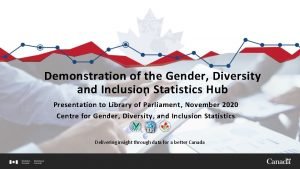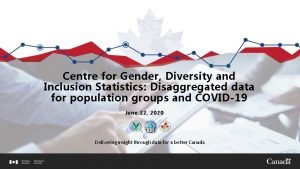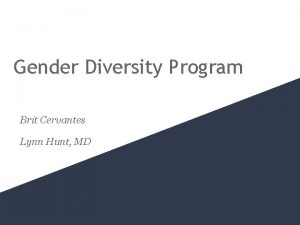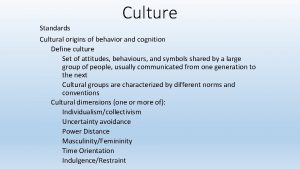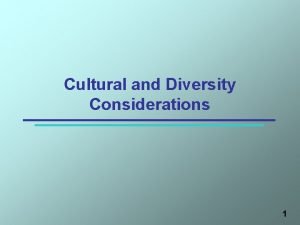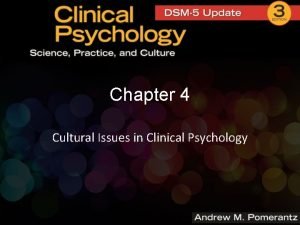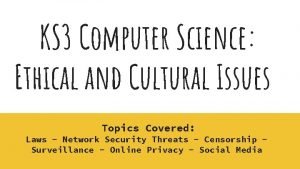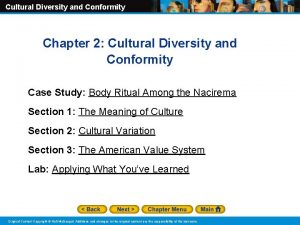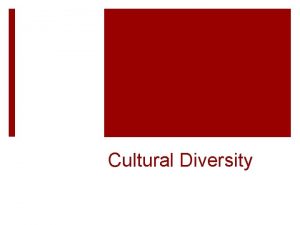Cultural Diversity Issues in Diversity Gender Language Groups












- Slides: 12

Cultural Diversity

Issues in Diversity Gender Language Groups Race Ethnicity Rural / Urban Special Needs – physical disabilities – mental disabilities

Ethnic & Racial Diversity in the United States In 1950 minorities made up 11% of the U. S. population. This figure increased to 30% by 2000. By 2014, 40% of the Illinois population will be none-white. By 2030, 50% of the US population will be non-white. By 2030, Caucasians will be the largest minority in the U. S.

Stereotypes -- An Example How do people walk? How do rich women walk?

Stereotypes are broadly held. Can you name stereotypes for these groups? African Americans Arabs Asian Americans Catholics Fundamentalist Christians Jews Latino Americans Native Americans Polish Americans WASPs

Stereotypes are generally considered offensive. How do you feel about “your” ethnic and/or cultural and/or religious grouping stereotype?

Minority Status and Identity Development Minority management of cultural differences: – – – assimilation (melting pot) accommodation (vegetable soup) separation (rejection of dominant group) Cultural identity development -- Cross 1980, 1987 – pre-encounter stage (minority group members notice differences between selves and majority culture, but differences are not considered important) – encounter stage (minority member encounters discrimination in vivid form) – immersion stage (minority members immerse themselves in the ways of their ethnic group) – internalization stage (appreciate selves, but realize that differences don’t always correspond to group membership)

Multiculturalism Awareness of Differences Respect for Differences Affirmation of Differences

The Multicultural Classroom Hold everyone to the same standards. Use ethnic names in examples. Select course text books carefully. Ensure equal opportunity for all. Get to know your students. Assess each student’s needs. Celebrate student differences. Teach in a cultural / historical context when possible and appropriate. See “Affirming Differences” by Sonia Nieto, ch. 12

Clinical Experience Visit a high school physics classroom with a culturally diverse population. – Note the presence of members of unique cultural and ethnic groups. – Identify the varied educational needs of students from different cultural and ethnic groups. – In lab, recitation, or tutoring session, take advantage of any opportunity to work with students of culturally diverse backgrounds. – Prepare a written report of your findings and activities. Perform a cultural sensitivity assessment of a high school physics textbook.

Significant Problems with the Multiculturalism Movement Cultural “illiteracy” results from a lack of common understanding which can affect understanding. A common basis is needed for effective communication. For example, consider the first stanza of the Aussie classic “Waltzing Matilda. ” Once a jolly swagman camped by a bilibong under the shade of a kulibar tree, he sang as he sat and waited for his biliboil, you’ll come a waltzing Matilda with me! Multiculturalism can actually disenfranchise those who do not learn to speak a common language.

References Cross, W. E. , Jr. (1980). Models of psychological nigrescence: A literature review. In R. L. Jones (Ed. ), Black psychology. New York: Harper & Row. Cross, W. E. , Jr. (1987). A two-factor theory of black identity: Implications for the study of identity development in minority children. In J. S. Phinney & M. R. Rotheram (Eds. ), Children’s ethnic socialization. Beverly Hills: Sage Publications.
 Strategic gender needs and practical gender needs
Strategic gender needs and practical gender needs Centre for gender diversity and inclusion statistics
Centre for gender diversity and inclusion statistics Centre for gender diversity and inclusion statistics
Centre for gender diversity and inclusion statistics Uci gender diversity program
Uci gender diversity program Gender based violence
Gender based violence How are ethnic groups and religious groups related
How are ethnic groups and religious groups related The meaning of silence varies among cultural groups
The meaning of silence varies among cultural groups Cultural groups
Cultural groups Cultural groups examples
Cultural groups examples Gestures meaning
Gestures meaning Examples of non material culture
Examples of non material culture Cultural issues in clinical psychology
Cultural issues in clinical psychology Cultural issues in computer science
Cultural issues in computer science

